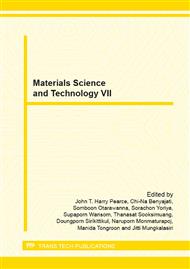p.8
p.14
p.19
p.24
p.31
p.36
p.47
p.52
p.57
Synchrotron Small Angle X-Ray Scattering Spectra of Iron-Based Magnetic Fluids
Abstract:
Magnetic fluid is a special class of materials which possesses the advantages of a liquid state of the carrier and a magnetic state of the particles. In addition to the conventional uses in mechanical engineering, magnetic fluids containing magnetite (Fe3O4) superparamagnetic nanoparticles are under research and development for drug delivery, hyperthermia and MRI contrast agents. On the other hand, iron-platinum (FePt) is investigated as materials for ultrahigh density recording. Before their assembly into patterned media, the as-synthesized FePt nanoparticles in superparamagnetic state are commonly stored in forms of magnetic fluids. In this work, iron-platinum (FePt) nanoparticles with their surface modified by oleic acid and oleyleamine were synthesized from the polyol process. The starting material was an environmental friendly iron(III) acetylacetonate and the products were dispersed in n-hexane. In small-angle X-ray scattering (SAXS) measurements at the Synchrotron Light Research Institute, Thailand, each magnetic fluid was injected into a sample cell with aluminum foil windows and the X-ray of wavelength 1.55 Å from BL2.2 was used. The measured SAXS intensity profiles as a function of the scattering vector from 0.27 to 2.30 nm-1 were fitted and compared between two different reactions. Nanoparticles synthesized by using a higher amount of Fe(acac)3 were matched with monodisperse spheres of radius 2.4±0.3 nm. The other reaction with a reducing agent gave rise to smaller nanoparticles of two size distributions. From this work, the potential of synchrotron radiation to complement conventional characterization techniques in the investigation of nanoparticles for high density recording and biomedical applications is underlined.
Info:
Periodical:
Pages:
31-35
Citation:
Online since:
March 2013
Keywords:
Price:
Сopyright:
© 2013 Trans Tech Publications Ltd. All Rights Reserved
Share:
Citation:


